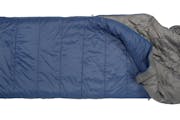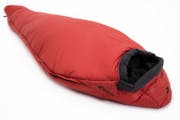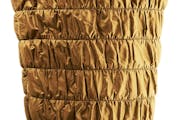Sleeping bag: all you need to know
Even when you’re outdoors, you want to enjoy a good, comfortable night’s sleep after your adventures. So your sleeping bag has to meet your requirements. This overview shows you the most important features of sleeping bags.
Find the right sleeping bag for you!
Material: down or synthetic fibre
You want your sleeping bag to keep you warm, and you’d prefer it to be light, but also strong and robust. Deciding between a down sleeping bag and a synthetic fibre one isn’t easy. Here are some tips to help you decide.
Down sleeping bag
Light, good balance between warmth and weight
Small packing size
Pleasant sleeping experience due to down absorbing moisture, however, down loses its insulating level very quickly if it gets too damp
Quite high-level care requirements
Very long-lasting with the correct care
Contains animal product
Synthetic fibre sleeping bag
Insulates even when damp
Robust, easy care requirements
Dries quickly
Tends to be cheaper than comparable down sleeping bags
Heavier, larger pack size
Less durable than down as synthetic fibre loses its insulation properties more quickly
So, it all depends: if you are travelling to cold and dry places, a down sleeping bag is probably the right choice for you. The same applies if you want to travel light. But if a humid, tropical area is on your itinerary, then a synthetic fibre sleeping bag might suit you better.
SizeSleeping bag size
It’s no fun carrying a sleeping bag with you that is too big. You’re just lugging extra weight around and on chilly nights you’ll get cold quicker because your body warmth spreads itself out more in a large sleeping bag. But your bag musn’t be too small, either. You want to be able to tuck your shoulders and head in. Also, you’ll flatten the insulation material more quickly in a small sleeping bag (with down and synthetic fibres). So the rule of thumb is this: when you are lying fully wrapped up in the sleeping bag and sitting up, it shouldn’t be stretched anywhere. In cold temperatures, you should also choose a slightly larger sleeping bag so you can keep your clothes or important items warm at your feet.
Temperature and fill powerTemperature and fill power
You really don’t want to wake up shivering in the middle of the night. Sweating isn’t pleasant either. Remember, it’s not the sleeping bag that keeps you warm, it’s your own body. The sleeping bag just provides insulation. And the bigger the sleeping bag, the more air you’ve got to keep warm.
For down sleeping bags, the higher the fill power the greater the down insulation level – at least with the same outer material. Fill power is given in cuin. This figure tells you how many cubic inches one ounce of down can expand to after it has been compressed. And the higher this figure is, the greater the amount of insulating air that is trapped. This is why it is important to spread out your sleeping bag before you go to bed. This lets the down expand. Also, make sure you have an insulating mat. The mat keeps the cold from the ground at bay. If you have a poor mat, you will probably get cold even in a good sleeping bag.
Cuin indicates how strong the down puffs up again after being compressed. The higher this value, the more air is trapped, which insulates.
If you go for a high fill power product, it will contain less down because the down is high quality. If the fill power is low, you need more down for insulation. This makes the product heavy and bulkier. We define good-quality down as having a rating around 800 cuin or above.
Synthetic fibres don’t have warmth ratings in cuin. The manufacturer specifies a warmth category based on various tests. Winter sleeping bags keep you warm at temperatures down to around -18 degrees, summer sleeping bags are comfortable from around six degrees and three-season sleeping bags from minus four to five degrees.
Temperature indications are made by manufacturers based on the following scale: Comfort means that an average woman is only just warm enough. Limit indicates that an average man in thermal underwear will not quite wake up. And extreme means that you may get frostbite, but you will survive the cold. Given the relative vagueness and the highly individual nature of all this, Transa corrects the values by about three degrees based on our own experience.
ShapesSleeping bag shapes
Depending on its shape, your sleeping bag may be better suited for a trekking tour with light baggage or for a summer holiday with a car and tent. The following overview shows you the most common types of sleeping bag and their pros and cons.

Blanket sleeping bag (rectangular)
These sleeping bags often open completely on one side and at the bottom. This enables you to use them as a blanket, sometimes combined with another sleeping bag. They offer plenty of room, but are usually heavy and have a large packing size.

Mummy sleeping bag
This sleeping bag hugs close to your body so you only need to warm up a small amount of air. This makes this type of sleeping bag suitable for cold temperatures. Mummy sleeping bags are also lightweight and have a small packing size due to their slim design. One thing to bear in mind is that because they sit so close to your body, you have less room to move in than with other types of sleeping bag. This is why mummy sleeping bags come in slim, normal and wide versions.

Double sleeping bag
Fancy sharing the a sleeping bag with your companion? If so, the double sleeping bag is the right choice for you. You have two bodies to warm the air in the sleeping bag, so you tend to need a bit less insulation. Some sleeping bags, including mummy bags, can also be easily connected to each other and used together or separately as preferred.
Sleeping bag weight
If you carry your sleeping bag with you all day while out trekking, packing size and weight are crucial criteria. When you’re camping with a vehicle, this is less relevant.
Light summer sleeping bags are available from weights of about half a kilo. Sleeping bags for low minus temperatures weigh up to three kilos.
Travel sleeping bags and linersTravel sleeping bags and liners
Very fine, single-layer sleeping bags, liners or travel sleeping bags are versatile:
Increase the thermal performance of the sleeping bag.
Extend the life of the sleeping bag because they minimise direct contact with the skin. Sweat and grease from the skin are mostly absorbed by the liner.
Easy to wash and quick to dry.
As a travel sleeping bag, it provides a hygienic barrier to sleeping areas where the bed linen cannot be changed regularly, such as in SAC huts, or where it is sometimes not very clean, such as when travelling.
Travel sleeping bags and liners are available in different materials.
Do you have any questions?
Get personal advice from our sales advisors in the shops or online and over the phone from customer service. We'll be happy to help you.
- Free shipping from CHF 99
(With the TransaCard always free of charge)
- Secure payment with Twint, Visa and more
- 14 days cancellation right


